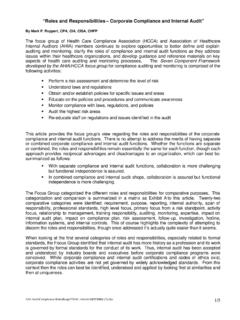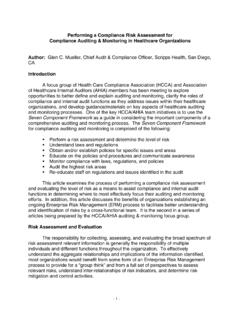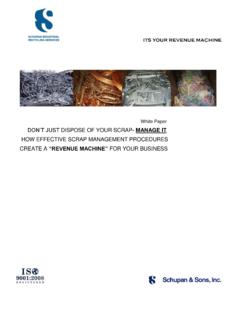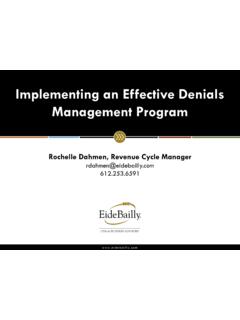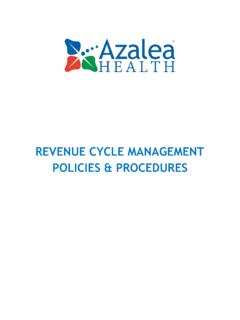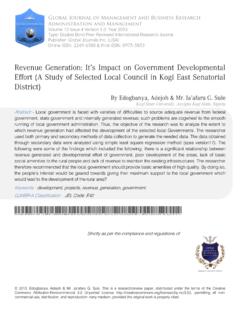Transcription of Evaluating Hospital Pharmacy Inventory Management and ...
1 Evaluating Hospital Pharmacy Inventory Management and revenue Cycle Processes White Paper Guidance for Healthcare Internal Auditors Introduction Pharmacy Inventory Management is a complex but critical process within the healthcare delivery system. Without adequate Pharmacy Inventory Management practices, hospitals run the risk of not being able to provide patients with the most appropriate medication when it is most needed. Additionally, pharmacies'. dispensing patterns and drug selection choices may have a direct effect on the affordability of care. Utilizing drugs that are non-contracted or not on the formulary may be more costly to the patient or may result in a lower than expected reimbursement. In addition to patient safety and financial considerations, stringent regulatory requirements pertaining to drug traceability, Inventory reporting and Inventory Management elevate the importance of maintaining effective control over drug inventories in today's ever- expanding healthcare compliance environment.
2 Pharmacies can control a number of factors within the Pharmacy Inventory Management and Pharmacy revenue cycles that can support better outcomes for patients and enhance the bottom line for facilities. This whitepaper provides perspectives on leading practices and internal controls pertaining to: procurement, charge description master maintenance, tracking systems, traceability, storage, disposal and segregation of duties. These control mechanisms can provide a basis for consistent quality, better financial performance and improved regulatory compliance when implemented appropriately and adhered to during day-to-day operations. Drug procurement Drug costs make up an increasing percentage of healthcare expenses. Proper Management of drug procurement is essential for addressing cost and promoting patient safety and quality care.
3 To ensure Pharmacy procurement activities are operating appropriately, Management should develop formal procurement procedures to be followed throughout the organization. These procedures should be reviewed regularly and updated as necessary to reflect changes in regulations and operations. They should be designed to promote safety and efficacy for drug purchases, and should include cost containment techniques, such as: Defining the process for formulary inclusion;. Utilizing a limited drug list or the formulary defining each drug to be purchased;. Practicing competitive bidding to secure optimal drug pricing;. Participating in the 340B Drug Pricing Program when eligible;. Taking advantage of greater purchasing power by teaming with industry partners in group purchasing (Note: certain restrictions may apply for 340B Program participants).
4 Limiting the use of local contracts negotiated outside of the group purchasing organizations; and Defining criteria for selecting drug product manufacturers and suppliers. For ordering controlled substances, Hospital pharmacies in the US must register with and abide by the requirements of the US Drug Enforcement Administration (DEA). The DEA categorizes controlled substances into five schedules. Schedule II includes controlled substances that are currently used for medical treatment and are considered to have a high potential for abuse, such as oxycodone, hydrocodone, hydromorphine, fentanyl, etc. Hospital pharmacies must order schedule I and II controlled substances on an official paper DEA 222 order form or electronically using DEA's Controlled Substances Ordering System The form must be executed or digitally signed by a DEA registrant.
5 1. Data analytics and benchmarking can be used by Hospital Pharmacy Management to evaluate medication costs relative to industry standards and to identify drugs that cost the Pharmacy more than the expected reimbursement received for their use. Data analytics can also be used to identify drugs with a missing or invalid National Drug Code (NDC). The National Drug Code Directory is available online at the Food and Drug Administration's (FDA) website. Incorrect NDC data can cause inaccurate billing and may negatively impact patient safety. Some facilities use software to automate the NDC update process in order to keep NDC data current and reduce errors. This automation can be particularly beneficial during drug shortages when suppliers and products may change frequently.
6 In addition to cost Management techniques and strong controls around drug procurement, Hospital Pharmacy Management must properly monitor the processing and payment of drug vendor invoices to ensure that products ordered were correctly received and invoiced. Sufficient supporting documentation should be maintained for Pharmacy purchases evidencing drugs received match the type and quantity reflected on the vendor invoice. Data analytics can also be used to compare the price on the vendor invoices to the negotiated or contracted drug purchase price. Finally, for eligible participants, the 340B. program may present significant savings opportunities; however, participation is contingent upon a Hospital adhering to strict regulatory standards.
7 Participating hospitals should therefore consider implementing strong internal controls including, but not limited to, a formalized compliance program. Considerations when conducting an internal audit: Is the formulary appropriate? o Select a sample of new drugs and obtain the applicable Pharmacy and Therapeutics Committee meeting minutes to ascertain approval for changes to the formulary. o Analyze the formulary against the NDC for completeness and accuracy. o Analyze drug costs compared to industry standards and expected reimbursement to identify high cost outliers. How are controlled substances ordered? o Test a sample of controlled substance orders and request the manual DEA 222 form or electronic documentation. Test system access to procure controlled substances to ensure it is limited to licensed pharmacists.
8 Are appropriate approvals in place prior to invoice payment? o Select a sample of drug payments and obtain the associated receipt and invoice support. Verify invoice pricing is aligned to contractual terms. Verify that all transactions were appropriately approved and payment aligns to goods received and ordered. For 340B Program participants: o Analyze internal controls documented within program policies and operational procedures as well as accuracy of program registration documentation. o Test of sample of 340B Pharmacy claims to assess whether the product was dispensed to an eligible patient and that the drug was not purchased under a group purchasing contract. For Medicaid Claims, assess whether claims were appropriately billed.
9 2. Drug receipt and storage Drugs received and stored in a Pharmacy can be placed into Inventory through a number of avenues. When drugs are received, before placing them into Inventory , Pharmacy personnel should perform appropriate receipt procedures, such as reconciling drugs received to drugs ordered, to ensure that discrepancies between quantity and drug type do not exist. Once the drugs received have been verified, they should be physically maintained in secure storage areas or active dispensing areas of the Pharmacy . Drug storage can include the use of automated dispensing devices where drugs are directly scanned and input into the Pharmacy Management system according to the type of substance, allowing for automatic tracking and Inventory counts.
10 Controlled substances require additional storage security to prevent any unauthorized access and must be received by authorized personnel with a DEA Form 222 (purchaser's copy) completed and acknowledged by the pharmacist. For storage, pharmacies can utilize narcotic vaults - that remain locked and restrict access within the Pharmacy or automated dispensing machines - which require controlled substances to be individually placed into secured bins. Both forms of storage should be restricted through badge access or biometric readers. In instances where drugs are placed and maintained on Pharmacy shelves, a typical procedure and leading practice used is called stock rotation . Newly purchased drugs with later expiration dates should be placed behind drugs that are already in Inventory .
